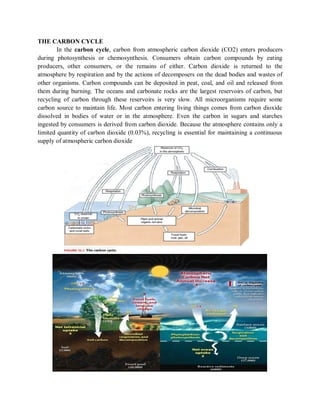
biogeochemical_cycle.pdf
- 1. THE CARBON CYCLE In the carbon cycle, carbon from atmospheric carbon dioxide (CO2) enters producers during photosynthesis or chemosynthesis. Consumers obtain carbon compounds by eating producers, other consumers, or the remains of either. Carbon dioxide is returned to the atmosphere by respiration and by the actions of decomposers on the dead bodies and wastes of other organisms. Carbon compounds can be deposited in peat, coal, and oil and released from them during burning. The oceans and carbonate rocks are the largest reservoirs of carbon, but recycling of carbon through these reservoirs is very slow. All microorganisms require some carbon source to maintain life. Most carbon entering living things comes from carbon dioxide dissolved in bodies of water or in the atmosphere. Even the carbon in sugars and starches ingested by consumers is derived from carbon dioxide. Because the atmosphere contains only a limited quantity of carbon dioxide (0.03%), recycling is essential for maintaining a continuous supply of atmospheric carbon dioxide
- 2. THE NITROGEN CYCLE Nitrogen is present in the environment in a wide variety of chemical forms including organic nitrogen, ammonium(NH4 + ), nitrite(NO2 - ), nitrate(NO3 - ), nitrous oxide(N2O), nitric oxide (NO) or inorganic nitrogen gas (N2). Organic nitrogen may be in the form of a living organism, humus or in the intermediate products of organic matter decomposition. The processes in the nitrogen cycle is to transform nitrogen from one form to another. Many of those processes are carried out by microbes, either in their effort to harvest energy or to accumulate nitrogen in a form needed for their growth. For example, the nitrogenous wastes in animal urine are broken down by nitrifying bacteria in the soil to be used by plants. 1. Nitrogen fixation The conversion of nitrogen gas (n2) into nitrates and nitrites through atmospheric, industrial and biological processes is called nitrogen fixation. Atmospheric fixation Nitrogen must be processed, or "fixed", into a usable form to be taken up by plants. Between 5 and 10 billion kg per year are fixed by lightning strikes. Industrial fixation Today, about 30% of the total fixed nitrogen is produced industrially using the haber-bosch process, which uses high temperatures and pressures to convert nitrogen gas and a hydrogen source (natural gas or petroleum) into ammonia Microbial fixation Most fixation is done by free-living or symbiotic bacteria known as diazotrophs. These bacteria have the nitrogenase enzyme that combines gaseous nitrogen with hydrogen to produce ammonia, which is converted by the bacteria into other organic compounds. Most biological nitrogen fixation occurs by the activity of mo-nitrogenase, found in a wide variety of bacteria and some archaea. Mo-nitrogenase is a complex two- component enzyme that has multiple metal-containing prosthetic groups. An example of free-living bacteria is azotobacter. Symbiotic nitrogen-fixing bacteria such as rhizobium usually live in the root nodules of legumes (such as peas, alfalfa, and locust trees). Here they form a mutualistic relationship with the plant, producing ammonia in exchange for carbohydrates. Because of this relationship, legumes will often increase the nitrogen content of nitrogen-poor soils. A few non-legumes can also form such symbioses. 2. Assimilation Plants can absorb nitrate or ammonium from the soil by their root hairs. If nitrate is absorbed, it is first reduced to nitrite ions and then ammonium ions for incorporation into amino acids, nucleic acids, and chlorophyll. In plants that have a symbiotic relationship with rhizobia, some nitrogen is assimilated in the form of ammonium ions directly from the nodules. It is now known that there is a more
- 3. complex cycling of amino acids between rhizobia bacteroids and plants. The plant provides amino acids to the bacteroids so ammonia assimilation is not required and the bacteroids pass amino acids (with the newly fixed nitrogen) back to the plant, thus forming an interdependent relationship. While many animals, fungi, and other heterotrophic organisms obtain nitrogen by ingestion of amino acids, nucleotides, and other small organic molecules, other heterotrophs (including many bacteria) are able to utilize inorganic compounds, such as ammonium as sole n sources. Utilization of various n sources is carefully regulated in all organisms. 3. Ammonification When a plant or animal dies or an animal expels waste, the initial form of nitrogen is organic. Bacteria or fungi convert the organic nitrogen within the remains back into ammonium (NH4 + ), a process called ammonification or mineralization. 4. Nitrification The conversion of ammonium to nitrate is performed primarily by soil-living bacteria and other nitrifying bacteria. In the primary stage of nitrification, the oxidation of ammonium (NH+ 4) is performed by bacteria such as the Nitrosomonas species, which converts ammonia to nitrites (NO− 2). Other bacterial species such as Nitrobacter, are responsible for the oxidation of the nitrites (NO− 2) into nitrates (NO− 3). It is important for the ammonia (NH3) to be converted to nitrates or nitrites because ammonia gas is toxic to plants. 5. Denitrification Denitrification is the reduction of nitrates back into nitrogen gas (N2), completing the nitrogen cycle. This process is performed by bacterial species such as Pseudomonas and Paracoccus, under anaerobic conditions. They use the nitrate as an electron acceptor in the place of oxygen during respiration. These facultatively (meaning optionally) anaerobic bacteria can also live in aerobic conditions. Denitrification happens in anaerobic conditions e.g. waterlogged soils. The denitrifying bacteria use nitrates in the soil to carry out respiration and consequently produce nitrogen gas, which is inert and unavailable to plants.